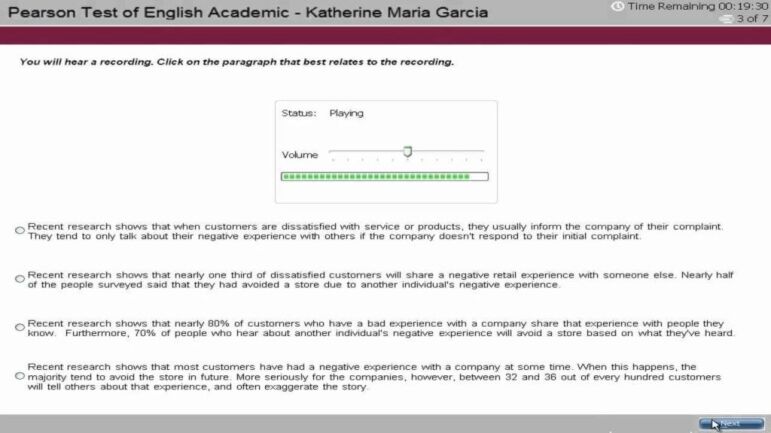
PTE stands for the Person Test of English and was invented in 2009. It is the first widely accepted proficiency test to be marked entirely by computer. Candidates take the exam on a computer at a registered test center. The PTE test lasts approximately three hours. Candidates may take a short break after the writing or reading sections.
PTE is still fairly new when compared to IELTS or other popular proficiency tests. Students can now take the PTE exam in over 50 countries. There are now over 250 official test centers around the world, and centralized marking by the person test engine prevents regional variation and increases reliability.
Students often find the structure of the PTE test confusing as the numbers of questions and timings in the different sections are all displayed as a range. This will become clear when you study the test structure table provided below.
Some students take PTE after struggling with the IELTS exam. It is fair to say that PTE provides a slightly easier route to Australian immigration. Certainly, the writing section seems significantly easier for most students. The speaking, listening, and reading sections also seem moderately easier than their IELTS or TOEFL counterparts.

The PTE test is accepted for immigration or University admission to Australia and New Zealand. An increasing number of higher education institutions and professional organizations are starting to accept the PTE test. Canadian or UK immigration might start to accept PTE in the future according to rumors, but this seems unlikely due to these countries’ support for CELPIP and IELTS, respectively.
Taking PTE in Dubai involves finding a good exam center. Booking your test for a weekday is advisable as it will normally be quieter, and this will mean less background noise. The PTE test is available six days per week in Dubai, and there are different timeslots to choose from. The entire exam takes approximately three hours to complete and you may take a 10-minute comfort break between the sections.
Most students only get the score they deserve if they take a good quality PTE preparation course. PTE classes should cover all 20 of the scored task types found in the exam. The majority of the audio recordings used in the exam are of native speakers from the USA, the UK, Australia, and Canada.
This means that native speaker teachers are the best choice for PTE test preparation courses. This is because students become accustomed to listening to these accents and pick out keywords or the gist of the recordings in the listening part of the test more easily.

The PTE test is split into three sections. The first section assesses the speaking and writing skills, second is the reading section, and finally the listening part of the test. The following table shows the structure of the PTE test with some brief tips:
| PTE Task | Skills Scored | Number of Tasks | Time | Time to Answer | Brief Tips |
| Part 1: Speaking & Writing | |||||
| Personal Introduction | Unscored | 1 | 30 seconds | Prepare a brief introduction before the exam | |
| Read Aloud | Reading and speaking | 6-7 | 30-35 minutes | 30-40 seconds | Focus on clarity, rhythm, and word stress |
| Repeat Sentence | Listening and speaking | 10-12 | 15 seconds | Practice replaying sentences in your head | |
| Describe Image | Speaking | 6-7 | 40 seconds | Ask your teacher for a clear template to follow | |
| Retell Lecture | Listening and speaking | 3-4 | 40 seconds | Learn some useful lecture language to structure and your summary | |
| Answer Short Question | Listening and speaking | 10-12 | 10 seconds | Give specific answers and make multiple attempts | |
| Summarise Written Text | Reading and writing | 2-3 | 50-60 minutes | 10 minutes | Review your use of conjunctions |
| Write Essay | Writing | 1-2 | 20 minutes | Ask your teacher for an essay model to follow | |
| Part 2: Reading | |||||
| Multiple-choice: Single Answer | Reading | 2-3 | 32-41 minutes | 2 minutes | Read the question prompt carefully |
| Multiple-choice: Multiple Answer | Reading | 2-3 | 3-4 minutes | Practice skimming and scanning | |
| Re-order Paragraphs | Reading | 2-3 | 2 minutes | Learn to recognise the clues | |
| Reading: Fill in the Blanks | Reading | 4-5 | 1.5 minutes | Practice your collocations | |
| Reading & Writing: Fill in the Blanks | Reading and writing | 5-6 | 1.5 minutes | Improve your AWL vocabulary | |
| Part 3: Listening | |||||
| Summarise Spoken Text | Listening and writing | 2-3 | 20-30 minutes | 10 minutes | Write short, concise sentences |
| Multiple-choice: Multiple Answers | Listening | 2-3 | 23-28 minutes | Take notes of key points | |
| Fill in the Blanks | Listening and writing | 2-3 | Use your grammar to help with word endings and forms | ||
| Highlight Correct Summary | Listening and reading | 2-3 | Take note of key statistics and what they refer to | ||
| Multiple-choice: Single Answer | Listening | 2-3 | Read the question prompt carefully | ||
| Select Missing Word | Listening | 2-3 | Focus on the meaning of the recording | ||
| Highlight Incorrect Words | Listening and reading | 2-3 | Click on any different words quickly and move on | ||
| Write from Dictation | Listening and writing | 3-4 | Use grammar and collocation to help complete the sentence correctly | ||
The scoring of the speaking section involves the use of a speech processing system. Pearson developed this specifically for the purpose of grading human speech. This system is specially designed to analyze and assess native and non-native speakers of English, and its development involved the analysis of almost 400,000 spoken responses from 10,000 test takers. It can accurately assess syntax (word order), lexis (vocabulary), collocation, grammar, and pronunciation. Trained to analyze over 120 different accents, the speech processor should not be biased towards specific accents. Still, it remains to be seen whether PTE provides reliability, validity, and consistency as compared to more traditional English proficiency tests such as IELTS or TOEFL.
Pearson’s trademark Intelligent Essay Assessor (IEA), powered by their knowledge analysis technologies engine, is responsible for grading the writing. This powerful processor, over 20 years in development, is the first computer system that is widely trusted to assess English speaking and writing proficiency for immigration and university admissions.
Pearson claims that this automated approach to scoring speaking and writing for English proficiency tests more accurately measures the English language ability of non-native speakers than human examiners.
For anyone still confused as to how a computer can reliably score human speaking and writing exercises, there is an in-depth explanation of their automated scoring system here:




Lastly, be confident. Believe in yourself, your ability, and the tips and strategies taught by your teacher. There is no restriction on the number of times you can take PTE and stress about your performance will only make things worse. Think positive, sit up straight, and give it your best shot!